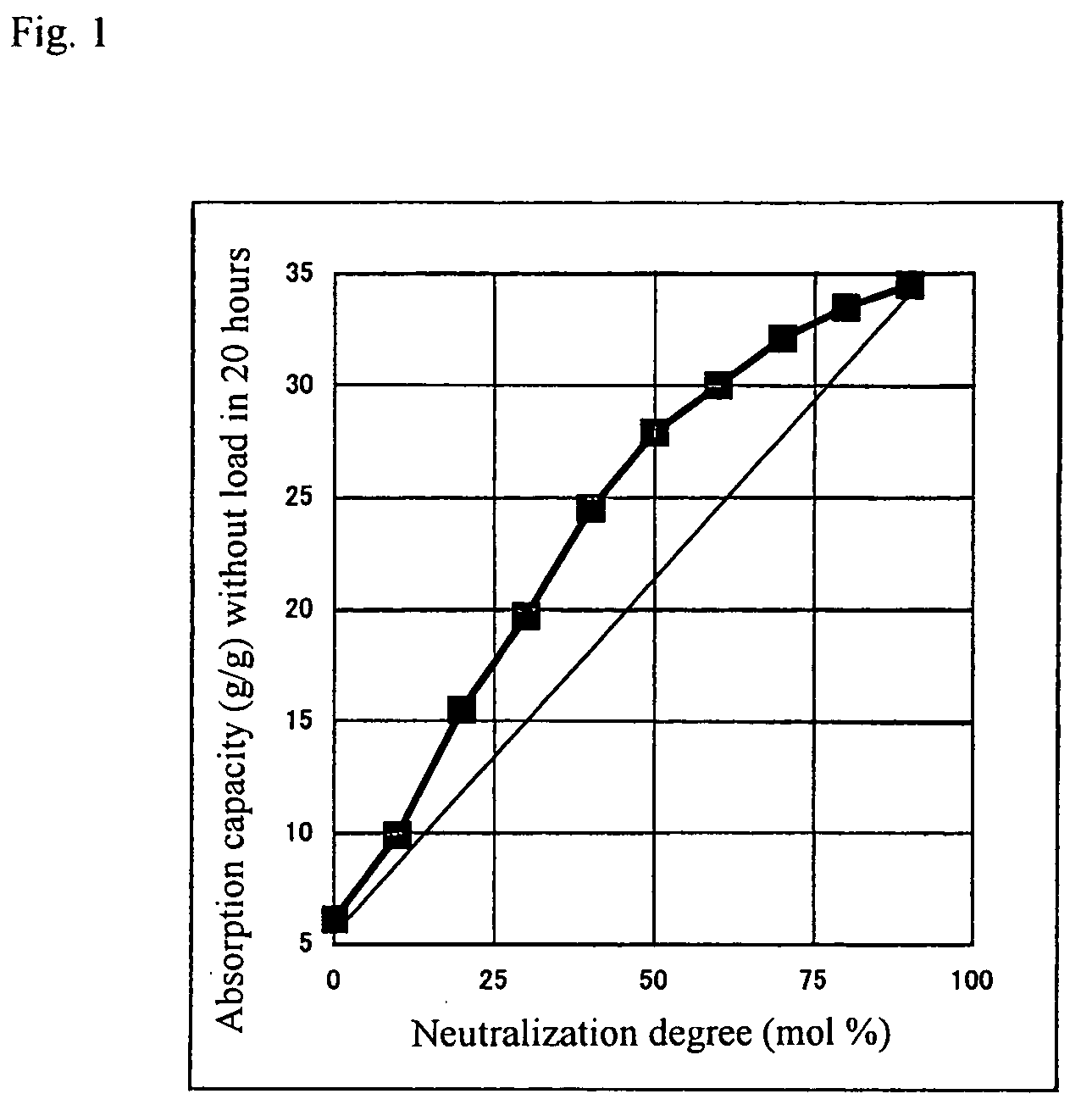Particulate water-absorbent resin composition
a technology of water-absorbing resin and composition, which is applied in the direction of bandages, natural mineral layered products, cellulosic plastic layered products, etc., can solve the problems of inferior absorption performance, diffuse urine, and difficulty in absorption, so as to improve the absorption performance and avoid leakage problems. , the effect of absorption ability
- Summary
- Abstract
- Description
- Claims
- Application Information
AI Technical Summary
Benefits of technology
Problems solved by technology
Method used
Image
Examples
referential example 1
Referential Example 1 investigated how the absorption behavior changed due to neutralization of an unneutralized water-absorbent resin. Incidentally, the measurement of the absorption capacity in Referential Example 1 adopted the following method different from the above measurement method of the absorption capacity without load (CRC).
An amount of 0.20 g of the water-absorbent resin particles (L-1) (having been obtained from Synthetic Example 1) was weighed out precisely to a level of 0.0001 g and then uniformly placed and sealed into a bag made of nonwoven fabric (85 mm×60 mm). Such samples were prepared to the number of 10.
A plastic-made container of 1,000 mL in capacity having a lid was charged with 1,000 mL of 0.90 mass % aqueous sodium chloride solution. Such containers were prepared to the number of 10. Added into these containers were sodium hydroxide needed for neutralizing 0%, 10%, 20%, 30%, 40%, 50%, 60%, 70%, 80%, and 90% respectively of the carboxyl groups of the re...
synthetic example 2
Synthesis of Water-absorbent Resin Particles (H-1)
In a reactor as prepared by lidding a jacketed stainless twin-arm kneader of 10 liters in capacity having two sigma-type blades, there was prepared a reaction liquid by dissolving 9.36 g (0.08 mol %) of polyethylene glycol diacrylate (molar-number-average degree of addition polymerization of ethylene oxide: 8) into 5,438 g of aqueous solution of sodium acrylate having a neutralization degree of 71.3 mol % (monomer concentration: 39 mass %). Next, dissolved oxygen was removed from this reaction liquid under an atmosphere of nitrogen gas for 30 minutes. Subsequently, 29.34 g of 10 mass % aqueous sodium persulfate solution and 24.45 g of 0.1 mass % aqueous L-ascorbic acid solution were added thereto under stirred conditions. As a result, polymerization started after about 1 minute. Then, the polymerization was carried out while the forming gel was pulverized. The polymerization initiation temperature was 20° C., and the highest tempe...
synthetic example 3
Synthesis of Water-absorbent Resin Particles (L-2)
A reaction liquid was prepared by putting 2,000 g of acrylic acid, 4.275 g of methylenebisacrylamide, and 7,724 g of water into a polyethylene-made beaker of 10 L and then dissolving them uniformly. Next, dissolved oxygen was removed from this reaction liquid under an atmosphere of nitrogen gas for 30 minutes. Subsequently, 60.5 g of 10 mass % aqueous V-50 (2,2′-azobis(2-amidinopropane) dihydrochloride) solution, 66.6 g of 3 mass % aqueous hydrogen peroxide solution, and 99.9 g of 0.5 mass % aqueous L-ascorbic acid solution were added thereto under stirred conditions. As a result, polymerization started after about 10 minutes. Then, polymerization was completed by leaving the reaction container alone at room temperature for 12 hours. Then, the resultant crosslinked hydrogel polymer was taken out and then pulverized with a meat chopper (produced by Iizuka Kogyo Co., Ltd., type: VR-400K, die diameter: 9.5 mm). The crosslinked hydrog...
PUM
| Property | Measurement | Unit |
|---|---|---|
| mass-average particle diameter | aaaaa | aaaaa |
| mass-average particle diameter | aaaaa | aaaaa |
| particle diameters | aaaaa | aaaaa |
Abstract
Description
Claims
Application Information
 Login to View More
Login to View More - R&D
- Intellectual Property
- Life Sciences
- Materials
- Tech Scout
- Unparalleled Data Quality
- Higher Quality Content
- 60% Fewer Hallucinations
Browse by: Latest US Patents, China's latest patents, Technical Efficacy Thesaurus, Application Domain, Technology Topic, Popular Technical Reports.
© 2025 PatSnap. All rights reserved.Legal|Privacy policy|Modern Slavery Act Transparency Statement|Sitemap|About US| Contact US: help@patsnap.com

